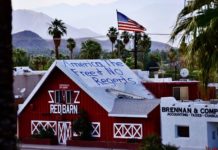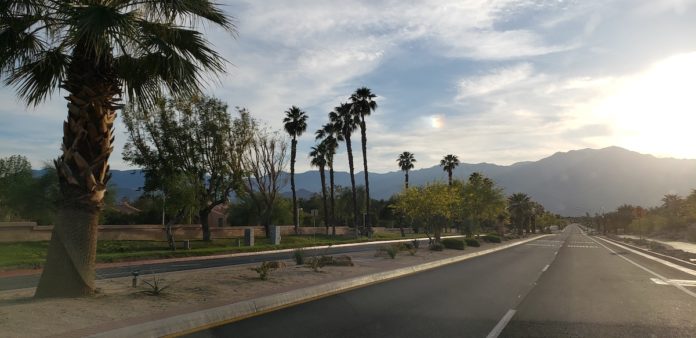Cactus Hugs has been tracking local stories about the coronavirus. For a rundown of all of our updates, click here. Stay safe, stay at a good social distance.
Thank you for your continued support of Cactus Hugs. For ways to keep this website going (and free!), click here.
As of 1 pm Tuesday, Riverside County officials have confirmed:
- 3,735 people have tested positive for COVID-19. 92 people have tested positive in the last 24 hours.
- 141 people are confirmed to have died in the county from the coronavirus. There were zero reported deaths in the last 24 hours.
- There are currently 220 confirmed cases hospitalized, with 73 of them in the ICU.
- There have been 1,303 official recovered cases in the county.
As of 4 pm Tuesday, San Bernardino County has confirmed 1,827 cases of COVID-19. There have been 85 deaths in San Bernardino County.
As of 3 pm Tuesday, there have been 46,032 confirmed cases of COVID-19 in California. There have been 1,862 confirmed deaths in the state. 76 people were reported dead from coronavirus in the state as of 4 pm Tuesday.
The U.S. has now reached more than 1 million confirmed cases of COVID-19 — more than anywhere else in the world. https://t.co/uFh1teswVS
— NPR (@NPR) April 28, 2020
According to Johns Hopkins University's tally of cases in the United States, there are at least 1,010,717 confirmed cases of coronavirus in the U.S.
At least 58,365 people have died in the U.S. from coronavirus.
(58,220 Americans died in the Vietnam War from 1964-1975.)
— Jake Tapper (@jaketapper) April 28, 2020
The numbers are increasing everyday. They are not just numbers. They are people. The individual stories are heartbreaking:
Gireesh Kumar was 67 when he died in a Long Island nursing home. His son, rapper Himanshu Suri, said he thought his father had been tested for coronavirus, only to discover that it never happened due to a shortage of nasal swabs. https://t.co/pesZkv12qQ
— CNN International (@cnni) April 28, 2020
Darrin Adams wanted to turn his life around after spending time in prison.
He'll receive his college degree posthumously after he died of the coronavirus this month.https://t.co/s7GU9atkYB
— BuzzFeed News (@BuzzFeedNews) April 28, 2020
“She encountered a lot of racism,” her son said. “She didn’t take it home with her. She left it at the door.” Corliss Henry, a retired nurse, has died of the new coronavirus at 95. https://t.co/3LePVlBsSt
— NYT Metro (@NYTMetro) April 28, 2020
The LA Times profiles a couple in their 80s, both recovered from coronavirus, who were treated in March at Eisenhower in Rancho Mirage:
But on this Thursday morning in April, perched on a wheelchair in the living room he thought he would never see again, Bob Borns tears up over and over. It mostly happens when he talks about how grateful he is. For his long life. For his loving family. For the nurses who helped him and Sandra fight off death.
“Angels without wings,” he calls them, over and over again. When their shifts ended, they promised the man some dubbed “Papa” that they would see him in the morning, that he would get better. He was ‘shocked,’ he says, ‘that anybody would give a damn so much. And work so hard.”
Our ‘Angels without wings’ helped save this couple. Thanks to @latimes @marialaganga for sharing this beautiful story of #hope https://t.co/X9zA92fvpH
— Eisenhower Health (@EisenhowerHeal) April 28, 2020
The LA Times also reports on the region during the pandemic:
The Coachella Valley may be best known for music festivals, tennis tournaments and championship golf, but it’s also home to some of the densest concentrations of senior citizens in California — the very same people with the greatest risk of contracting the coronavirus simply because of the year they were born.
An epidemiologist at Eisenhower health told KMIR that protective measures and physical distancing may have saved hundreds of lives in the Coachella Valley. “From April 14 to yesterday, we potentially have averted about 4 to 5 thousand COVID cases in our valley and about 300 deaths averted potentially,” Dr. Patricia Cummings said.
As the results of antibody tests begin to come in, disease experts are finding that the coronavirus is significantly more lethal than seasonal flu. “I think it is the worst pandemic since 1918,” an epidemiologist told the Washington Post.
Dr. Anthony Fauci warned Americans could be in for “a bad fall and a bad winter” if the United States isn’t prepared for the return of the coronavirus on Tuesday. “If by that time we have put into place all of the countermeasures that you need to address this, we should do reasonably well. If we don’t do that successfully, we could be in for a bad fall and a bad winter”
Dr. Anthony Fauci warns Americans could be in for "a bad fall and a bad winter" if the US isn’t prepared for the return of the coronavirus. Follow live updates: https://t.co/uufSosKdJ4 pic.twitter.com/WAgsq0tKEv
— CNN Breaking News (@cnnbrk) April 28, 2020
Gov. Gavin Newsom outlined the planned stages to lift the stay-at-home order in California on Tuesday. According to the governor, the state is currently in Stage 1, which focuses on safety and preparedness. Stage 2 would see the reopening of lower risk workplaces like offices and retail spaces with curbside pickup. Stage 3 would see higher risk workplaces like movie theaters, hair salons, and live sporting events without crowds begin to open, with limitations. Stage 4 would see the end of the stay-at-home order. Newsom stated, “I know we’re all ready for life to go back to normal. But it’s unbelievably important we re-open our economy in a scientific, thoughtful way — guided by public health. Our stores will look different. Offices will operate differently. But we will be healthier.”
STAGE 1: Safety and Preparedness.
This is where we are now.
Staying home and flattening the curve.
Building out our testing, PPE, and hospital capacity.
Making our essential workplaces as safe as possible.
And preparing sector-by-sector guidelines for a safe re-opening.
— Gavin Newsom (@GavinNewsom) April 28, 2020
STAGE 3: Higher Risk Workplaces
Gradually re-opening some higher risk environments with adaptations and limits on size of gatherings.
This will include:
-Personal care (hair salons, nail salons, gyms)
-Movie theaters
-Sports without live audiences
-In-person religious services— Gavin Newsom (@GavinNewsom) April 28, 2020
I know we're all ready for life to go back to normal.
But it's unbelievably important we re-open our economy in a scientific, thoughtful way — guided by public health.
Our stores will look different. Offices will operate differently. But we will be healthier.
— Gavin Newsom (@GavinNewsom) April 28, 2020
Newsom also stated that classrooms in the state could reopen as early as July, with some modifications. No official decision has been made, but Newsom acknowledged there have been “learning losses” since schools were closed.
NEW: Governor Gavin Newsom says California schools may start the school year early next year, beginning late July or early August to make up for lost learning.
He says this is a consideration, not definitive.
— Ashley Zavala (@ZavalaA) April 28, 2020
Riverside County residents who lost jobs due due to the pandemic may be eligible for up to $800 in financial assistance by enrolling in the county’s workforce assistance programs. A $252,000 state grant will help pay for housing, utilities, child care, transportation and telecommuting, according to the county. For more information, call 951-955-9742 or send an email to workforcehelp@rivco.org.
President Trump said on Tuesday that he plans to sign an executive order on Tuesday aimed at addressing concerns about meat shortages because of plant closings due to the coronavirus. Details were not provided, but a source familiar with the plans told NPR that he will invoke the Defense Production Act to ensure beef, pork, poultry and egg plants keep running.
Vice President Pence toured the Mayo Clinic on Tuesday:
Ignoring hospital policy, Vice President Mike Pence tours Mayo Clinic without a mask https://t.co/ZxXvzOKcQY pic.twitter.com/RLGC805fpo
— TIME (@TIME) April 28, 2020
Hosts are being trained on how to disinfect their homes, rooms are required to be vacant for 24 hours between stays, prospective guests able to choose places to stay that have been unoccupied for at least 3 days (the length of time coronavirus can live in plastic and steel) – NPR reports on how Airbnb is adjusting to COVID-19.
The Coachella Valley Recovery Team is looking for owners or managers of any-sized business to participate in a survey of how the local economy has been impacted by the coronavirus. You can take the survey here.
The Palm Springs Aerial Tramway’s Mountain Station light is now blue, to honor essential workers:
Finally, some people are making very good use of their time in the quarantine:
Quarantined in France — this guy doing his best Freddie Mercury on the balcony while playing “I Want to Break Free” is the Twitter content I’m here for…?❤️??pic.twitter.com/YYtiz005gX
— Rex Chapman?? (@RexChapman) April 27, 2020
That’s all for this evening. Stay safe. Stay smart. Stay home.
Thank you for your continued support of Cactus Hugs.
Important information:
Congressman Raul Ruiz has posted a list of local resources and information.
The Washington Post offers plenty of ways that you can help during the coronavirus pandemic.
If you see someone price gouging, there is now a number for that.
The New York Times has an interactive map where you can track every coronavirus case in the United States.
The Washington Post is out with a guide to what you should know about the coronavirus.
Here is a memo by the Department of Homeland security identifying critical infrastructure workers.
The United Way of the Desert has assembled a nice list of information and resources available during the coronavirus here.
These are scary and anxious times. Be safe and kind to each other out there and, please, remember to wash your hands.
Anything we missed? Let us know about it.








